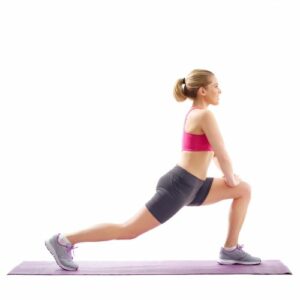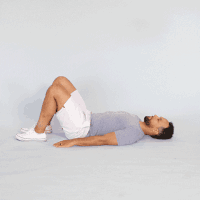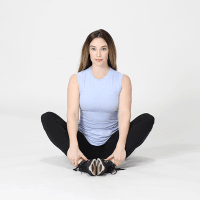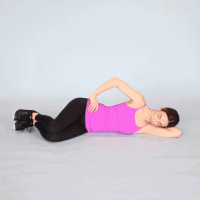Ah, youth—a time of vigor, boundless energy, and… hip pain? As a young adult, you’d expect your body to be in its prime, resiliently taking on every adventure you throw at it. But what happens when those spontaneous things get overshadowed by an aching discomfort in your hip? Many young adults are surprised to discover that they’re not immune to such pains. The good news? Recognizing it now, in the dawn of your adulthood, can lead to a pain-free future. Dive into this comprehensive guide to understand the reasons behind hip pain in young adults, and more importantly, find actionable solutions to ensure that as you stride into the rest of your life, you do so with strength, confidence, and most crucially, without pain.
Contents
Common Causes of Hip Pain in Youth
 In the vigor of youth, with all its activity and enthusiasm, the hip—a major weight-bearing joint—can sometimes take a toll. Let’s unpack the common causes that could be behind the hip pain young adults often experience:
In the vigor of youth, with all its activity and enthusiasm, the hip—a major weight-bearing joint—can sometimes take a toll. Let’s unpack the common causes that could be behind the hip pain young adults often experience:
- Sports Injuries: Engaging in high-impact sports or intensive training can sometimes lead to acute injuries. Whether it’s soccer, basketball, or long-distance running, the constant strain and rapid movements can lead to sprains or strains in the hip region.
- Overuse and Repetitive Motion: It’s not just athletes who are at risk. Repeated actions, like cycling long distances regularly or even certain gym exercises, can cause overuse injuries. This repetitive stress without adequate rest can irritate the hip joint or the muscles around it.
- Hip Labral Tears: The labrum is a ring of cartilage that follows the outside rim of your hip joint socket. Due to its location and function, it’s susceptible to tears. Young adults who are particularly active or who have had a trauma to the hip might experience a labral tear, leading to pain and sometimes a clicking sensation in the hip.
- Early-Onset Arthritis: While arthritis is more commonly associated with older age, it’s not exclusive to it. Early-onset or juvenile arthritis can affect young adults, causing inflammation and pain in the hip joint.
- Structural Issues: Some individuals might have hip dysplasia or other congenital conditions that weren’t symptomatic during childhood but manifest pain in the young adult years.
- Other Medical Conditions: Conditions like hip bursitis, tendinitis, or even infections can be a source of hip discomfort in younger individuals.
Recognizing the root cause of hip pain is the first step towards effective treatment and prevention. It’s always beneficial to consult a healthcare professional if you suspect any of these conditions to get a precise diagnosis.
Early Warning Signs to Watch Out For

For young adults, it’s especially crucial to ensure that these issues don’t hinder their active lifestyles. Let’s dive into the early warning signs that might indicate an underlying hip issue:
- Localized Pain: A consistent pain in the groin, thigh, or buttock area, especially after prolonged activity or exercise, can be a telltale sign of hip-related concerns.
- Stiffness or Limited Range of Motion: Difficulty in moving the hip, or feeling a restriction when trying to perform specific actions like bending or turning, can be an early indicator.
- Clicking or Popping Sounds: Any unusual noise from the hip joint, especially when accompanied by pain, should not be ignored. It could be indicative of a labral tear or other joint issues.
- Limping or Altered Gait: If you find yourself limping or altering your walking pattern due to hip discomfort, it’s a sign that the hip joint or surrounding muscles might be stressed.
- Swelling or Tenderness: Any visible swelling around the hip joint or a tender feeling when touched can be indicative of inflammation or injury.
- Pain that Intensifies with Activity: If hip discomfort exacerbates with physical activities or certain movements, it could be a sign of overuse injuries or underlying conditions like tendinitis.
- Nighttime Discomfort: Pain in the hip that disrupts sleep or is more pronounced at night can be a red flag.
- Prolonged Morning Stiffness: If the hip feels notably stiff upon waking up and takes more than 30 minutes to loosen up, it could hint at conditions like arthritis.
Recognizing these symptoms early on and taking them seriously is paramount. It allows for prompt intervention, potentially preventing the progression of the condition. The sooner you address potential hip problems, the better you’re poised for a pain-free and active life ahead.
Home Remedies & Quick Fixes
 For many young adults, the hustle and bustle of daily life can sometimes lead to neglecting minor aches and pains. However, when hip discomfort makes an appearance, it’s essential to have some go-to solutions at hand. Here are some easy home remedies and quick fixes to help alleviate mild hip pain:
For many young adults, the hustle and bustle of daily life can sometimes lead to neglecting minor aches and pains. However, when hip discomfort makes an appearance, it’s essential to have some go-to solutions at hand. Here are some easy home remedies and quick fixes to help alleviate mild hip pain:
- Cold and Hot Compress:
- Cold Compress: Applying an ice pack can help reduce inflammation and numb the area, offering instant relief. Always wrap the ice pack in a cloth to avoid direct contact with the skin.
- Hot Compress: Warmth can relax and loosen tissues and stimulate blood flow to the area. Use a hot water bottle or a warm towel for this.
- Epsom Salt Bath: Epsom salt contains magnesium, which can help reduce muscle soreness and relax the area. Add a cup to your bathwater and soak for about 15-20 minutes.
- Over-the-Counter Pain Relievers: Non-prescription medications like ibuprofen or acetaminophen can be effective for short-term relief. However, it’s essential to use them as directed and ensure they don’t interfere with any other medications.
- Gentle Stretching: Gentle hip stretches can help relieve tension and improve flexibility. Examples include the butterfly stretch, hip flexor stretch, and pigeon pose. Always ensure you’re doing them correctly to avoid further injury.
- Maintain a Healthy Weight: Carrying extra weight can put additional stress on the hips. Keeping within a healthy weight range can reduce this strain.
- Supportive Footwear: Wearing shoes that provide adequate support can ensure proper alignment and reduce stress on the hip joint.
- Turmeric and Ginger Tea: Both turmeric and ginger have anti-inflammatory properties. Drinking a warm tea made from these can help reduce pain and inflammation.
- Topical Pain Relievers: Gels or creams containing ingredients like menthol or capsaicin can provide temporary relief when applied to the affected area.
While these remedies can provide temporary relief, it’s essential to monitor persistent or worsening symptoms.
Exercises You Can Do To Get Relief
For young adults, the discomfort and limitations resulting from hip pain can be more than just a mere inconvenience; they can hinder daily activities, passions, and pursuits. Fortunately, with a proactive approach centered on exercise and physical therapy, there’s a road to relief and potentially even prevention.
Hip Flexor Stretch

Begin in a lunge position with the knee of the affected hip on the ground. Gently push your pelvis forward until you feel a stretch in the front of your hip. Hold for 20-30 seconds and repeat.
Piriformis Stretch

Lie on your back with both knees bent. Cross the ankle of the affected side over the opposite knee and gently pull your bottom knee towards your chest. Hold for 20-30 seconds.
Butterfly Stretch

Sit down with your feet together and your knees bent outward. Press your knees towards the ground using your elbows for a gentle stretch in the inner hips.
Clamshells

Lying on your side, bend your knees at 90 degrees. Keeping your feet together, lift the top knee as high as you can without moving your pelvis. Lower it down slowly.
Bridges

Lying on your back with knees bent, lift your hips off the ground, squeezing your glutes at the top. Slowly lower down.
Single Leg Deadlifts

Holding a light weight in one hand, stand on the opposite leg. Keeping a slight bend in your standing knee, lean forward, lifting the other leg behind you. Return to standing.
Incorporating these exercises into a regular routine can significantly alleviate discomfort, but consistency is key.
Modern Interventions & Treatment Options
The medical landscape is ever-evolving, with innovative interventions emerging that specifically address the unique needs and challenges faced by young adults experiencing hip pain. These treatments not only offer relief but often come with shorter recovery times, fewer complications, and a focus on long-term health. Here’s an overview of some of the pioneering solutions available:
Physical Therapy

- Tailored Programs: Young adults can benefit from bespoke therapeutic exercises designed to strengthen the hip muscles, improve flexibility, and optimize joint function.
- Manual Techniques: Physical therapists utilize hands-on approaches, such as joint mobilizations or soft tissue massage, to alleviate pain and enhance movement.
- Education: Knowledge is power. By understanding their condition and the mechanics of their body, young adults are better equipped to prevent recurrences and manage symptoms.
Regenerative Medicine
- Platelet-Rich Plasma (PRP) Injections: Utilizing a patient’s own blood, PRP therapy concentrates and extracts growth factors to promote healing and reduce inflammation in the hip.
- Stem Cell Therapy: A cutting-edge treatment where stem cells are harvested and then injected into the injured hip area to foster healing and tissue regeneration.
Hip Arthroscopy
- Minimally Invasive: Unlike traditional open surgery, hip arthroscopy involves small incisions, resulting in less tissue damage, reduced pain, and a faster recovery.
- Diagnostic & Therapeutic: Beyond just treating the problem, arthroscopy provides a detailed view of the hip joint, allowing doctors to accurately diagnose issues that might be missed in standard imaging tests.
Other Minimally Invasive Procedures
- Radiofrequency Ablation (RFA): Using radio waves to produce heat, targeted nerve tissues are heated, reducing pain signals from that area.
- Corticosteroid Injections: While used judiciously, these can provide significant relief from inflammation and pain, especially in acute flare-ups.
While it’s promising to see the array of treatments available, it’s essential for young adults to consult with healthcare professionals. By understanding the cause and nature of their hip pain, they can make informed decisions that prioritize both immediate relief and long-term health.
Conclusion
Navigating the complexities of hip pain in your youth can be challenging, especially when you’re standing at the threshold of numerous adventures that adulthood promises. It’s crucial to address this discomfort early on, ensuring that it doesn’t become a persistent issue that hampers your quality of life. Physical therapy, especially, has shown remarkable results in managing, alleviating, and often reversing hip pain, tailoring solutions that fit the unique needs of young adults. So, don’t let hip pain dictate the pace of your life. If you’re experiencing Hip pain, physical therapy for hip pain at PhysioMantra can help: Book an online physical therapy session.



